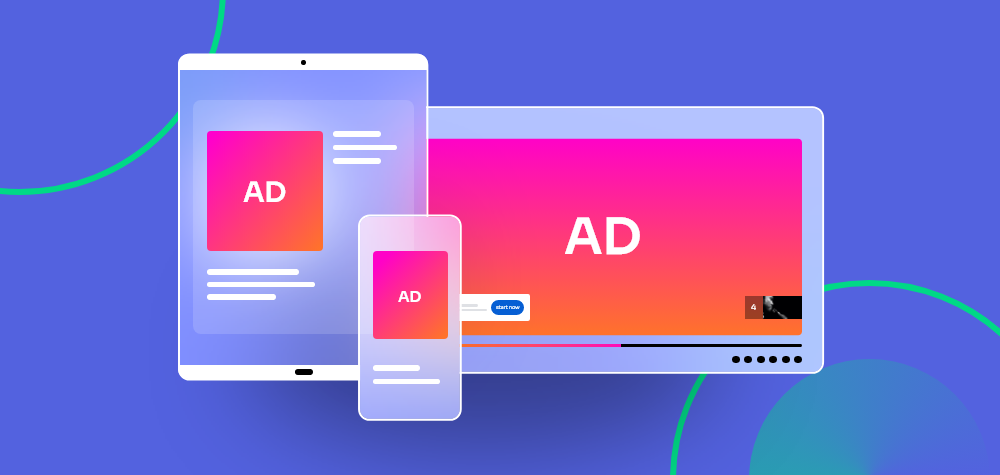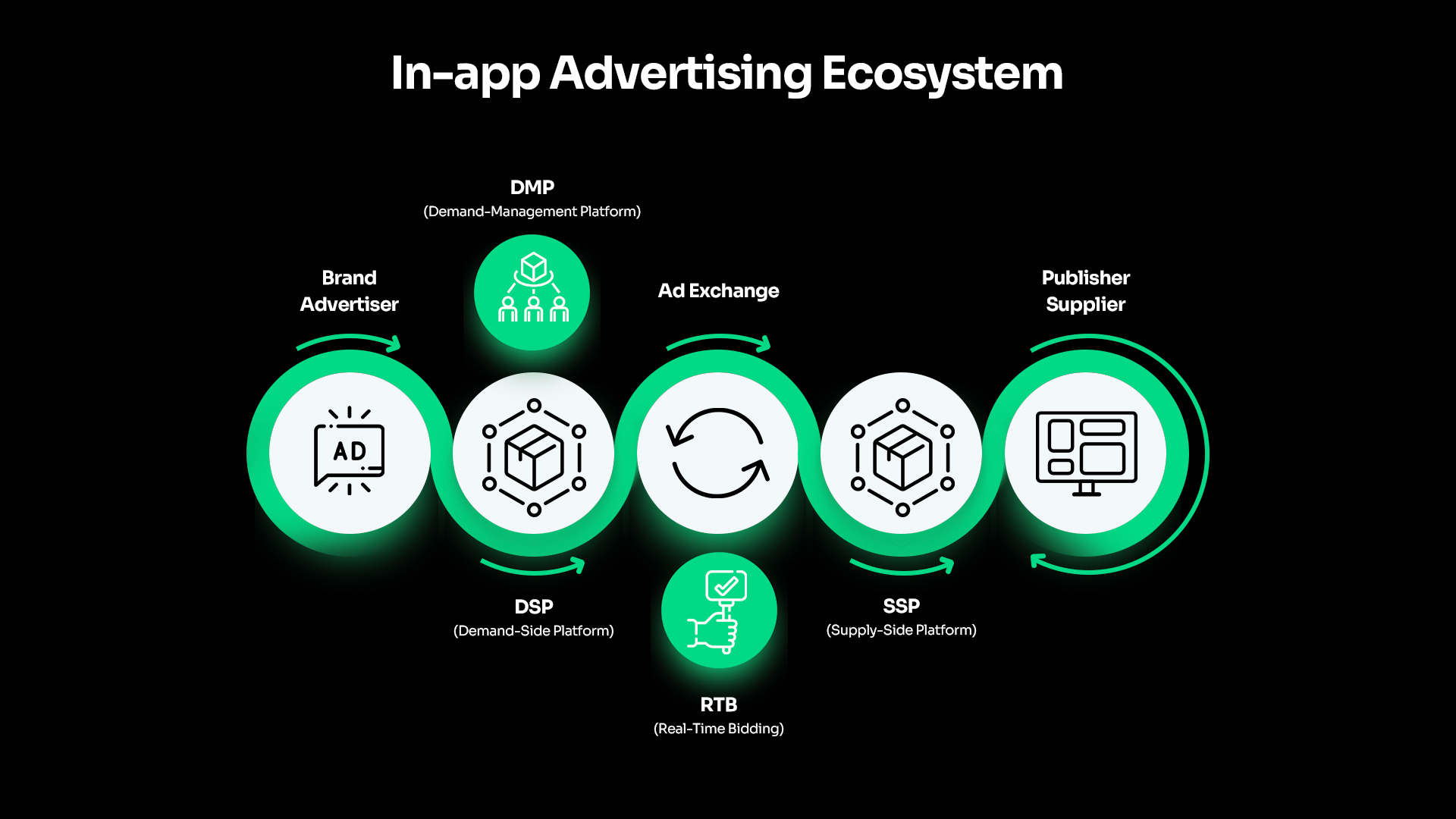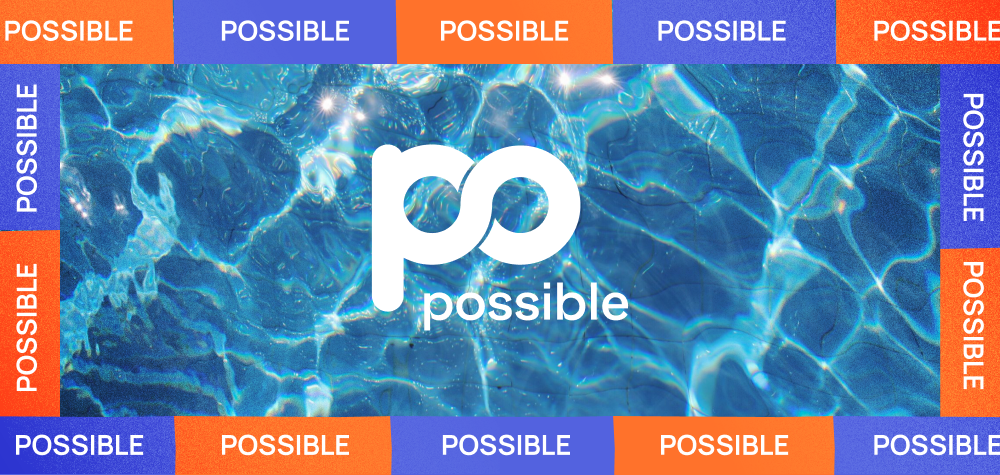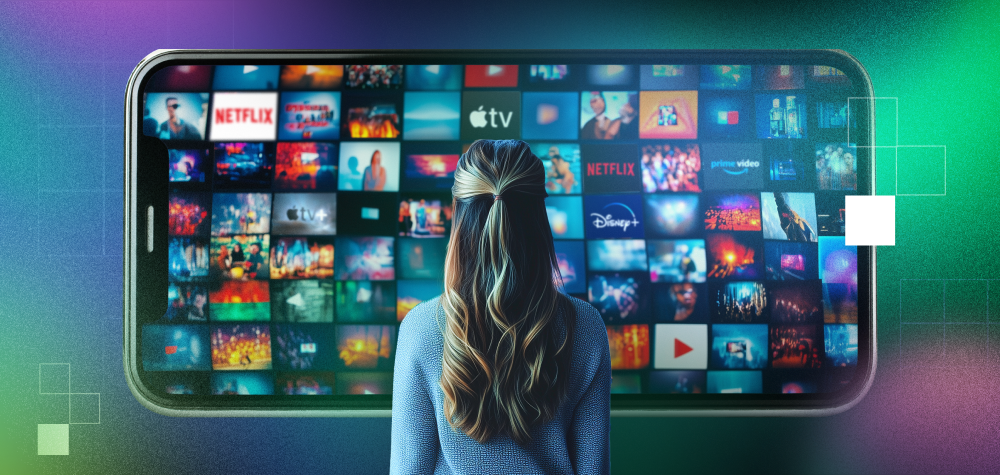In 1994, the very first banner ad appeared on the internet. Thirty years later, there are billions of digital ads served online every day. More than 80% of them are programmatic display ads.
‘Programmatic’ is a term describing the complex process of computerized, algorithmic ad buying that fuels the digital ecosystem. Programmatic ad technology is the preferred method advertisers use to buy display ads, mobile ads, in-app ads, digital out-of-home ads, audio ads, and connected TV ads.
Advertisers spent an estimated $558 billion on programmatic advertising in 2023. By the year 2026, industry experts expect advertisers to spend $700 billion on programmatic ads.
Source – Statista
Programmatic advertising is growing quickly because it solves significant pain points for both sides of the transaction: Advertisers and content publishers.
Join us for a deep dive into the programmatic advertising ecosystem, how programmatic advertising works, the benefits, latest programmatic trends, and more.
What is programmatic advertising?
Programmatic advertising is the automated process of buying and selling ad placements in the digital ecosystem. Programmatic media buying connects content publishers and advertisers in real-time auctions for ad space on websites, apps, and any other digital screen where ads are placed.
Unlike traditional media buying, which involves a lot of complex and time-consuming manual work, programmatic buying enables centralized, automated, algorithm-based bidding on multiple publishers’ sites, so advertisers can win the best ad impressions at the best possible price for their target audience and campaign goals. For publishers, programmatic advertising helps drive website and mobile monetization by filling ad inventory automatically and in real time with the most suitable ads, with far less effort.
How does programmatic advertising work?
Every day, billions of ads are served on desktop, mobile and digital TV screens all over the world. Programmatic advertising automates the complex process of connecting thousands of advertisers and publishers in real-time auctions for available ad space, filling the space and serving ads instantly to the user.
Programmatic advertising relies on several online systems that connect with one another to make the media buying process happen. Let’s look at those systems and how they work together.
- An advertiser is looking to purchase ad space to promote their product or brand, so they turn to a trade desk or programmatic ad agency. These programmatic advertising companies use a demand side platform, or DSP, which automates the bidding and buying process on behalf of the advertiser.
- The DSP connects the ad agency to multiple publishers at once, bringing a wide range of options for where the ad might be placed. With the help of a data management platform, or DMP, the DSP analyzes audience data based on a range of parameters, such as geographic area, user behavior, and demographics, to decide which ad placement to bid for, and at what price.
- On the publisher side, there is the supply side platform, or SSP. Via this platform, publishers can supply ad inventory for DSPs to bid on. When a user lands on a website, the website sends a request to the SSP, the SSP connects to the DSP, and a micro-auction begins. The DSP bids on behalf of advertisers, using the DMP to decide which ads are best suited to the publisher’s visitor, and the ad placement is filled by the most suitable ad at the highest bid.
This entire process happens within the seconds it takes for the user’s website page or mobile app to load. For both sides of the transaction, programmatic advertising takes the manual work out of digital media buying and selling, while making it more optimized and efficient. In a complicated and constantly dynamic marketplace, programmatic advertising is a win-win for publishers and advertisers alike.
What are the 4 main types of programmatic advertising?
Programmatic advertising comes in several variations. Here are the 4 most common types of programmatic advertising used in the industry today:
Real-Time Bidding (RTB)
Real-time bidding is a type of programmatic advertising where advertisers compete for ad inventory in auctions conducted in real time. RTB operates with the CPM (cost per mille) model, meaning that advertisers set their bid and pay publishers for the ad space per 1,000 impressions.
Private Marketplace (PMP)
Private marketplace, or PMP, is a type of programmatic advertising that takes place in a closed auction, where a set of exclusive advertising partners participate. It provides advertisers with access to unique ad inventory that is not available on open exchanges. PMP enables publishers to tailor their inventory and provide specialty offerings to advertisers, giving them the opportunity to build relationships with advertiser partners.
Preferred Deals
A preferred deal is a programmatic buying method where the publisher and advertiser negotiate a price to purchase ad space. The media buyer gets preferential treatment, in that they are offered the opportunity to bid at the agreed-upon price. However, preferred deals are not guaranteed–the publisher does not need to hold the ad space at that price for the advertiser, and the advertiser is not obligated to bid for the space.
Programmatic Guaranteed
Programmatic guaranteed is when a publisher and advertiser negotiate the cost and terms of a particular ad inventory, and that inventory is reserved for the specific advertiser at the agreed-upon price.
What are the most common programmatic ad formats?
Programmatic advertising is used to buy and sell digital ad space for a wide range of formats and channels. Here is a quick overview of the ad formats that are available programmatically:
Display ads
Display ads, or banner ads, are ads that appear on desktop and mobile websites. They typically appear at the top or sides of a web page. Programmatic display is one of the most common types of digital advertising, as it offers an affordable and accessible way to reach large audiences. Despite their widespread adoption across the industry (or perhaps because of), display ads typically have relatively low clickthrough rates.
Video ads
Programmatic video advertising is a popular method for buying and selling video ad space, particularly for apps, connected TV and social media. Video is an effective advertising tool, generating higher engagement among audiences than simple display ads.
For example, a user completes a level on a gaming app and is about to move to the next level. The app publisher might provide a video ad here, during this transition between levels. Advertisers selling a product that is relevant to the user demographic can bid programmatically for this ad space and show a video ad that is likely to pique the user’s curiosity at this prime moment, when the user is enthused and engaged.
Social ads
An estimated 62% of the world’s population is on social media. Social programmatic advertising is a powerful tool to reach a vast audience efficiently and target them using their social graph and interests. Advertisers use DSPs to bid programmatically for ad space on social networks such as Facebook, Instagram, X (formerly Twitter), LinkedIn, Snapchat, TikTok, Reddit and more.
Native ads
Native ads are designed to fit the form and feel of the web page they appear on. Native ads are less disruptive than display ads, and users tend to “see” them more than other ad types. By partnering with a programmatic trade desk, advertisers can access native ad inventory programmatically, taking advantage of the more advanced targeting options that native ad exchanges typically offer, such as contextual targeting.
Audio ads
The digital audio industry has experienced rapid growth in recent years. Roughly 42% of Americans aged 12+ report they listened to a podcast in the last 30 days, according to a survey from Edison Research. An estimated 90 million Americans—or roughly 1 out of 4 people—now pay for a streaming music subscription, Forbes reports. Advertisers can bid programmatically for digital audio ad space on platforms such as podcasts, music streaming apps and digital radio.
Digital out-of-home (DOOH)
Digital-out-of-home advertising includes digital billboards and screens positioned in public spaces. DOOH is an important part of an omnichannel advertising campaign, as it enables brands to reach customers when they are out and about, and not on their phones or computers. With programmatic advertising for DOOH, advertisers can bid automatically for this important ad space at the most effective times and locations.
In-app programmatic advertising
In the U.S., people spend an average of 4 hours and 25 minutes a day on their phones, making in-app advertising an attractive option for advertisers. Mobile programmatic advertising works the same way as programmatic advertising on the web, however in-app ads have unique formats and sizing to fit the smaller mobile screen. The main ad formats for in-app advertising include interstitial ads, banner ads, splash ads, rewarded ads, playable ads and rich media ads.
What are the benefits of programmatic advertising?
Programmatic advertising has benefits for both advertisers and publishers. Here’s why:
Reach
Programmatic advertising connects advertisers with tens of thousands of publishers at once, so the potential audience reach across platforms is far larger. For publishers, the programmatic method makes their ad inventory available to an enormous pool of advertisers, increasing the competition for placements and boosting revenue. This is a good tactic for web and app monetization.
Omnichannel targeting
One of the biggest challenges for marketers today is generating audience awareness across several touchpoints, including desktop web, mobile web, apps, digital-out-of-home, and connected TV. Programmatic advertising enables advertisers to bid for optimal placements on all platforms in real time and build an effective multi-channel advertising strategy.
Automated tasks
Automation takes most of the legwork out of the online advertising process, making it simpler and easier to manage. More importantly, by eliminating most of the rote tasks of ad bidding, buying and placement, programmatic advertising frees up advertisers to focus their resources on audience research and strategic optimization to get more from their campaigns.
Real-time results and optimization
Data transparency is a huge benefit of programmatic ads. By tracking campaign results in real time, advertisers are better positioned to optimize ads effectively and get better results from their campaigns faster. Furthermore, the transparency afforded by programmatic platforms enable advertisers to assess publishers in real time based on ad performance and avoid low-quality and fraudulent placements.
Better ROI
Automation, data-based insights, and enhanced optimization capability in real time all add up to higher return on investment for advertisers. Programmatic advertising enables advertisers to keep a finger on the pulse of multiple campaigns running on several platforms in one centralized operation, so they can make optimization decisions faster, and get better return on ad spend.
Improve ROI by following programmatic advertising best practices
By keeping up with programmatic best practices and mastering the latest hacks and tools, advertisers can maximize their campaign potential and ROAS. Let’s look at the programmatic advertising best practices you should follow today:
Align your goals to ad type and channel
All digital campaigns should be based on specific goals and KPIs, and this is no different for programmatic ads. To achieve the best possible performance, make sure to define and align the objective of your ad campaign to the programmatic channel and ad type. For example, the campaigns for programmatic display and in-app ads will have very different creatives and KPIs, even as they promote the same product or service.
Segment your audience
By grouping your audience into user segments based on their location, online behavior, interests, or marketing funnel stage (awareness, consideration, conversion), it will be easier to target them with programmatic ads that offer the right message at the right time. Explore your web and mobile audiences to understand them better, identify their pain points and segment them accordingly. Then you can use programmatic methods to target and optimize ad campaigns in real time to the best potential segments.
Use data to drive decisions
With programmatic, advertisers have access to a broad set of real-time data across all campaigns and channels, to understand which ads are performing best and why. Advertisers should take full advantage of this information to make smart and accurate decisions about campaign targeting and optimization, to get better ROI for their ad spend.
Test and optimize
Programmatic advertising is the ideal platform to test and optimize campaigns to drive better performance over time. Use the fast-moving pace of programmatic to your advantage by frequently A/B testing campaigns and optimizing in real time according to the results.
Use an omnichannel approach
Programmatic advertising works best with a multi-channel approach, targeting audiences on different channels at different times. By reaching out to audiences across multiple touchpoints and media, such as mobile web, video, apps, out-of-home, connected TV, retargeting, and more, you can access a larger pool of data that can be used to test campaigns and scale them for the best results.
Programmatic advertising trends for 2024
The programmatic advertising ecosystem is developing exponentially, supporting scale and performance potential that was unheard of in the early days of RTB auctions. Let’s explore some of the programmatic advertising trends that have the industry buzzing now:
Contextual signals > cookies
Digital advertising has traditionally relied on third-party cookies to identify and target suitable audiences. With cookie depreciation on the horizon, this will soon no longer be an option. Programmatic advertising is trending toward contextual targeting of first-party data, in which audiences are grouped according to interests and shown relevant ads. Contextual signals, such as content topics, page categories and lookalike audiences, will be the future of programmatic targeting.
The rise of omnichannel ads
The shift towards an omnichannel programmatic advertising strategy is already happening and will only accelerate in the future. Brands are operating in a highly competitive marketplace where grabbing consumer attention is tougher than ever before. Programmatic ad technology enables advertisers to better craft, promote and optimize campaigns across all channels, automatically, and in real time.
AI in programmatic advertising
Artificial intelligence and machine learning are rapidly advancing, and will be increasingly adopted in programmatic advertising to support even better ad targeting and optimization. Predictive AI will enable advertisers to pinpoint high-potential users with better accuracy and serve personalized ad experiences at a more granular level. Combined with the dynamic speed of programmatic advertising, advertisers will ramp up their performance at unprecedented precision and scale.
Check out our Programmatic Curation Guide for Advertisers and Publishers to learn how machine learning can drive personalization and better campaign performance.
How to get started with programmatic advertising?
There are numerous programmatic advertising examples and platforms for web, mobile, DOOH and CTV. Although similar, each has its own features, tools, and processes. Start.io supports mobile programmatic advertising, with more than 500,000 integrated apps and vast global reach of mobile audiences.
Download the Start.io advertising SDK today to monetize your mobile app.






